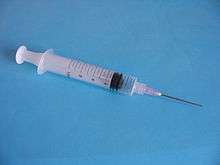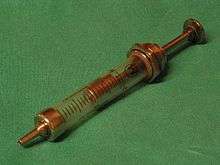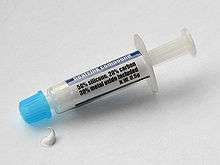Syringe

.jpg)
A syringe is a simple pump consisting of a plunger that fits tightly in a tube. The plunger can be pulled and pushed along inside a cylindrical tube (called a barrel), allowing the syringe to take in and expel a liquid or gas through an orifice at the open end of the tube. The open end of the syringe may be fitted with a hypodermic needle, a nozzle, or tubing to help direct the flow into and out of the barrel. Syringes are often used to administer injections, insert intravenous drugs into the bloodstream, apply compounds such as glue or lubricant, and measure liquids.
The word "syringe" is derived from the Greek σύριγξ (syrinx, meaning "tube") via back-formation of a new singular from its Greek-type plural "syringes" (σύριγγες).
Medical syringes


Sectors in the syringe and needle market include disposable and safety syringes, injection pens, needleless injectors, insulin pumps, and specialty needles.[2] Hypodermic syringes are used with hypodermic needles to inject liquid or gases into body tissues, or to remove from the body. Injecting of air into a blood vessel is hazardous, as it may cause an air embolism; preventing embolisms by removing air from the syringe is one of the reasons for the familiar image of holding a hypodermic syringe pointing upward, tapping it, and expelling a small amount of liquid before an injection into the bloodstream.
The barrel of a syringe is made of plastic or glass, usually has graduated marks indicating the volume of fluid in the syringe, and is nearly always transparent. Glass syringes may be sterilized in an autoclave. However, most modern medical syringes are plastic with a rubber piston, because this type seals much better between the piston and the barrel and because they are cheap enough to dispose of after being used only once, reducing the risk of spreading blood-borne diseases. Reuse of needles and syringes has caused spread of diseases, especially HIV and hepatitis, among intravenous drug users. Syringes are, however, commonly reused by diabetics, and this is safe if the syringe is only used by one person.[3] In medical settings, single-use needles and syringes effectively reduce the risk of cross-contamination.[4]
Medical syringes are sometimes used without a needle for orally administering liquid medicines to young children or animals, or milk to small young animals, because the dose can be measured accurately and it is easier to squirt the medicine into the subject's mouth instead of coaxing the subject to drink out of a measuring spoon.
Tip designs
Syringes come with a number of designs for the area in which the blade locks to the syringe body. Perhaps the most well known of these is the Luer lock, which simply twists the two together.
Bodies featuring a small, plain connection are known as slip tips and are useful for when the syringe is being connected to something not featuring a screw lock mechanism.
Similar to this is the catheter tip, which is essentially a slip tip but longer and tapered, making it good for pushing into things where there the plastic taper can form a tight seal. These can also be used for rinsing out wounds or large abscesses in veterinary use.
There is also an eccentric tip, where the nozzle at the end of the syringe is not in the centre of the syringe but at the side. This causes the blade attached to the syringe to lie almost in line with the walls of the syringe itself and they are used when the blade needs to get very close to parallel with the skin (when injecting into a surface vein or artery for example).
Standard U-100 insulin syringes
Syringes for insulin users are designed for standard U-100 insulin. The dilution of insulin is such that 1 mL of insulin fluid has 100 standard "units" of insulin.[5] Since insulin vials are typically 10 mL, each vial has 1000 units.
Insulin syringes are made specifically for self injections and have friendly features:
- shorter needles,[6] as insulin injections are subcutaneous (under the skin) rather than intramuscular,
- finer gauge needles,[6] for less pain, and
- markings in insulin units to simplify drawing a measured dose of insulin.[7]
- low dead space to reduce complications caused by improper drawing order of different insulin strengths.[8]
|
U-100 Syringe Sizes and Markings | |||
|---|---|---|---|
| 1cc (1 mL) Syringe | |||
| Holds maximum: | 100 units[9] | ||
| Numbered in: | 10 unit increments[9] | ||
| Smallest line measures 2 units:[10] | BD[9] ReliOn[11] Monoject[12] (all but 31 gauge needle) | ||
| Smallest line measures 1 unit: | Easy Touch[13] Precision Sure Dose[12] |
1/2cc (0.5 mL) Syringe | |
| Holds maximum: | 50 units[14] | ||
| Numbered in: | 10 unit increments[14] | ||
| Smallest line measures 1 unit:[10] | BD[14] Precision Sure Dose[12] Ulti-Care[12][15] Easy Touch[16] ReliOn[11] Monoject[12] | ||
| 3/10cc (0.3 mL) Syringe | |||
| Holds maximum: | 30 units[17] | ||
| Numbered in: | 5 unit increments[17] | ||
| Smallest line measures 1 unit:[10] | BD Micro Fine[12] BD Ultra Fine[12][17] (standard length only) Monoject[12] Easy Touch[18] UltiCare[12] | ||
| Half-unit scale 3/10cc (0.3 mL) Syringe[19] | |||
| Holds maximum: | 30 units[17] | ||
| Numbered in: | 5 unit increments[17] | ||
| Smallest line measures 1/2 unit: | BD Ultra Fine II (short)[12][17] ReliOn[11][12] | ||
Multishot needle syringes
There are needle syringes designed to reload from a built-in tank (container) after each injection, so they can make several or many injections on a filling. These are not used much in human medicine because of the risk of cross-infection via the needle. An exception is the personal insulin autoinjector used by diabetic patients.
Venom extraction syringes
Venom extraction syringes are different from standard syringes, because they usually do not puncture the wound. The most common types have a plastic nozzle which is placed over the affected area, and then the syringe piston is pulled back, creating a vacuum that allegedly sucks out the venom. Attempts to treat snakebites in this way are specifically advised against, as they are ineffective and can cause additional injury.[20]
Syringes of this type are sometimes used for extracting human botfly larvae from the skin.[21]
Oral
An oral syringe is a measuring instrument used to accurately measure doses of liquid medicine which are expressed in millilitres (mL). They do not have threaded tips, because no needle or other device needs to be screwed onto them. The contents are simply squirted or sucked from the syringe directly into the mouth of the person or animal.
Oral syringes are available in various sizes, from 1-10 mL and larger. The sizes most commonly used are 1 mL, 2.5 mL and 5 mL.[22]
Dental syringes
A dental syringe is a used by dentists for the injection of an anesthetic. It consists of a breech-loading syringe fitted with a sealed cartridge containing anesthetic solution.
The ancillary tool (generally part of a dental engine) used to supply water, compressed air or mist (formed by combination of water and compressed air) to the oral cavity for the purpose of irrigation (cleaning debris away from the area the dentist is working on), is also referred to as a dental syringe or a dental irrigation nozzle. A 3-way syringe / nozzle has separate internal channels supplying air, water or a mist created by combining the pressurized air with the waterflow. The syringe tip can be separated from the main body and replaced when necessary.
Governmental control of syringes
In some jurisdictions, the sale or possession of hypodermic syringes may be controlled or prohibited without a prescription,[23] due to its potential use with illegal intravenous drugs.[24]
Non-medical uses
The syringe has many non-medical applications.
Laboratory applications


Medical-grade disposable hypodermic syringes are often used in research laboratories for convenience and low cost. Another application is to use the needle tip to add liquids to very confined spaces, such as washing out some scientific apparatus. They are often used for measuring and transferring solvents and reagents where a high precision is not required. Alternatively, microliter syringes can be used to measure and dose chemicals very precisely by using a small diameter capillary as the syringe barrel.
The polyethylene construction of these disposable syringes usually makes them rather chemically resistant. There is, however, a risk of the contents of the syringes leaching plasticizers from the syringe material. Non-disposable glass syringes may be preferred where this is a problem. Glass syringes may also be preferred where a very high degree of precision is important (i.e. quantitative chemical analysis), because their engineering tolerances are lower and the plungers move more smoothly. In these applications, the transfer of pathogens is usually not an issue.
Used with a long needle or cannula, syringes are also useful for transferring fluids through rubber septa when atmospheric oxygen or moisture are being excluded. Examples include the transfer of air-sensitive or pyrophoric reagents such as phenylmagnesium bromide and n-butyllithium respectively. Glass syringes are also used to inject small samples for gas chromatography (1 μl) and mass spectrometry (10 μl). Syringe drivers may be used with the syringe as well.
Cooking
Some culinary uses of syringes are injecting liquids (such as gravy) into other foods, or for the manufacture of some candies.
Syringes may also be used when cooking meat to enhance flavor and texture by injecting juices inside the meat, and in baking to inject filling inside a pastry.
Others
Syringes are used to refill ink cartridges with ink in fountain pens.
Common workshop applications include injecting glue into tight spots to repair joints where disassembly is impractical or impossible; and injecting lubricants onto working surfaces without spilling.
Sometimes a large hypodermic syringe is used without a needle for very small baby mammals to suckle from in artificial rearing.
Historically, large pumps that use reciprocating motion to pump water were referred to as syringes. Pumps of this type were used as early firefighting equipment.
There are fountain syringes where the liquid is in a bag or can and goes to the nozzle via a pipe. In earlier times, clyster syringes were used for that purpose.
Loose snus is often applied using modified syringes. The nozzle is removed so the opening is the width of the chamber. The snus can be packed tightly into the chamber and plunged into the upper lip. Syringes, called portioners, are also manufactured for this particular purpose.
Syringes that are able to administer medication can be used to act as cap guns, where the projectile is not usually a cap but can be paper or aluminium pellets.
Historical timeline

- The first piston syringes were used in Roman times. During the 1st century AD Aulus Cornelius Celsus mentions the use of them to treat medical complications in his De Medicina.
- 9th century AD: The Iraqi/Egyptian surgeon Ammar ibn 'Ali al-Mawsili' created a syringe in the 9th century using a hollow glass tube, and suction to remove cataracts from patients' eyes, a practice that remained in use until at least the 13th century.
- c. 1650: Blaise Pascal invented a syringe (not necessarily hypodermic) as an application of what is now called Pascal's law.
- 1844: Irish physician Francis Rynd invented the hollow needle and used it to make the first recorded subcutaneous injections, specifically a sedative to treat neuralgia.
- 1853: Charles Pravaz and Alexander Wood developed a medical hypodermic syringe with a needle fine enough to pierce the skin.
- 1899: Letitia Mumford Geer of New York was granted a patent for "In a hand-syringe the combination of a cylinder, a piston and an operating-rod which is bent upon itself to form a smooth and rigid arm terminating in a handle, which, in its extreme positions, is located within reach of the fingers of the hand which holds the cylinder, thus permitting one hand to hold and operate the syringe..." [27]
- 1946: Chance Brothers in Smethwick, Birmingham, England produced the first all-glass syringe with interchangeable barrel and plunger, thereby allowing mass-sterilisation of components without the need for matching them.
- 1949: Australian inventor Charles Rothauser created the world's first plastic, disposable hypodermic syringe at his Adelaide factory.
- 1951: Rothauser produced the first injection-moulded syringes made of polypropylene, a plastic that can be heat-sterilised. Millions were made for Australian and export markets.
- 1956: New Zealand pharmacist and inventor Colin Murdoch was granted New Zealand and Australian patents for a disposable plastic syringe.
See also
- A fire syringe has two meanings: as a fire piston, a fire starting device; and a squirt, one of the first firefighting devices in history used to squirt water onto the burning fuel which was in the form of a large syringe.[28]
- Autoinjector, a device to ease injection, e.g. by the patient or other untrained personnel.
- Hippy Sippy
- Hypodermic needle
- Jet injector, injects without a needle, by squirting the injection fluid so fast that it makes a hole in the skin.
- Luer Taper, a standardized fitting system used for making leak-free connections between syringe tips and needles.
- Needle exchange programme, is a social policy based on the philosophy of harm reduction where injecting drug users (IDUs) can obtain hypodermic needles and associated injection equipment at little or no cost.
- Trypanophobia, a fairly common extreme fear of hypodermic syringes
- Syrette, similar to a syringe except that it has a closed flexible tube (like that used for toothpaste) instead of a rigid tube and piston.
- Syringing the ear to remove excess ear wax.
- Syrinx, the nymph from classical mythology after which syringes were supposedly named.
- Safety Syringe, with features to prevent accidental needlesticks and reuse
- Vaginal syringe
References
- ↑ (French) Swiss Telegraphic Agency, "Deux millions de personnes contaminées lors d'une injection à risque en 2014", Radio télévision suisse, 23 February 2015 (page visited on 23 February 2015).
- ↑ "Disposable Syringe Markets". TriMark Publications, LLC. June 2013.
- ↑ "Pediatric Oncall-Insulin Delivery-Injection". Pediatriconcall.com. Retrieved 2010-12-30.
- ↑ "Disposable Medical Supplies Markets". TriMark Publications, LLC. July 2014.
- ↑ "Making the unit of insulin PubMed". Bull Hist Med. 76 (2): 231–70. 2010-12-08. PMID 12060790.
- 1 2 "BD Diabetes-Insulin Syringe Needle Sizes". Bd.com. Retrieved 2010-12-30.
- ↑ "BD Diabetes-Syringe Capacity and Dose Size". Bd.com. Retrieved 2010-12-30.
- ↑ "Brigham Young University Sign-in Service".
- 1 2 3 "Close-up of BD 1cc Syringes-UltraFine-30 Gauge-1/2", UltraFine II Short-31 Gauge-5/16" & MicroFine-28 Gauge-1/2"". Retrieved 2010-12-30.
- 1 2 3 "Diabetes Mellitus-Washington State University". Vetmed.wsu.edu. Retrieved 2010-12-30.
- 1 2 3 "ReliOn Insulin Syringe Markings". Relion.com. Retrieved 2010-12-30.
- 1 2 3 4 5 6 7 8 9 10 11 "Diabetes Health Syringe Listings" (PDF). Retrieved 2010-12-30.
- ↑ "Easy Touch Syringe demonstration-their syringes all measure in 1 unit increments". Easytouchsyringes.com. Retrieved 2010-12-30.
- 1 2 3 "Close-up of BD 1/2 cc Syringes--UltraFine-30 Gauge-1/2", UltraFine II Short-31 Gauge-5/16" & MicroFine-28 Gauge-1/2"". Retrieved 2010-12-30.
- ↑ "Ulti-Care U100 Syringes-Product Information". Ulti-care.com. Retrieved 2010-12-30.
- ↑ "Easy Touch Syringes demonstration-all syringes with 1 unit increment markings". Easytouchsyringes.com. Retrieved 2010-12-30.
- 1 2 3 4 5 6 "Close-up of BD 3/10 Syringes-UltraFine-30 Gauge-1/2", UltraFine II Short-31 Gauge-5/16", UltraFine Short-Half Unit Markings-31 Gauge-5/16" & MicroFine-28 Gauge-1/2"". Retrieved 2010-12-30.
- ↑ "Easy Touch Syringes-all products measure in 1 unit increment markings". Easytouchsyringes.com. Retrieved 2010-12-30.
- ↑ "Comparison of 3/10 cc syringe marks--half unit and whole unit scale-BD". Retrieved 2010-12-30.
- ↑ Bush MD, Sean P. (February 2004). "Snakebite Suction Devices Don't Remove Venom: They Just Suck" (PDF). Annals of Emergency Medicine. 43 (2): 187–188. Retrieved 2014-12-24.
- ↑ Boggild, Andrea K.; Jay S. Keystone; Kevin C. Kain (August 2002). "Furuncular myiasis: a simple and rapid method for extraction of intact Dermatobia hominis larvae". Clinical Infectious Diseases. 35 (3): 336–338. doi:10.1086/341493. PMID 12115102. Retrieved 2014-09-28.
- ↑ "How to use your oral syringe". Netdoctor.
- ↑ "Children With Diabetes-Prescription Needed or Not?". Childrenwithdiabetes.com. Retrieved 2010-12-30.
- ↑ "Criminal Law and Syringe Disposal in Delaware". Retrieved 2012-04-03.
- ↑ "Hypodermic syringe". Retrieved 21 June 2012.
- ↑ Davenport-Hines, Richard (2004). The Pursuit of Oblivion : A Global History of Narcotics. New York: W.W. Norton. p. 68. ISBN 978-0-393-32545-4.
- ↑ "Patent US622848 - Letitia Mumford Geer".
- ↑ Walford, Cornelius. The insurance cyclopaedia: being a dictionary of the definitions of terms used in connexion with the theory and practice of insurance in all its branches: a biographical summary ... a bibliographical repertory of all works written upon the subject ... an . London: C. and E. Layton ;, 1871,1880. 337 Print.
Further reading
- Hans-Jürgen Bässler und Frank Lehmann : Containment Technology: Progress in the Pharmaceutical and Food Processing Industry. Springer, Berlin 2013, ISBN 978-3642392917
External links
| Wikimedia Commons has media related to Syringe. |
| Look up syringe in Wiktionary, the free dictionary. |
-solution.jpg)


